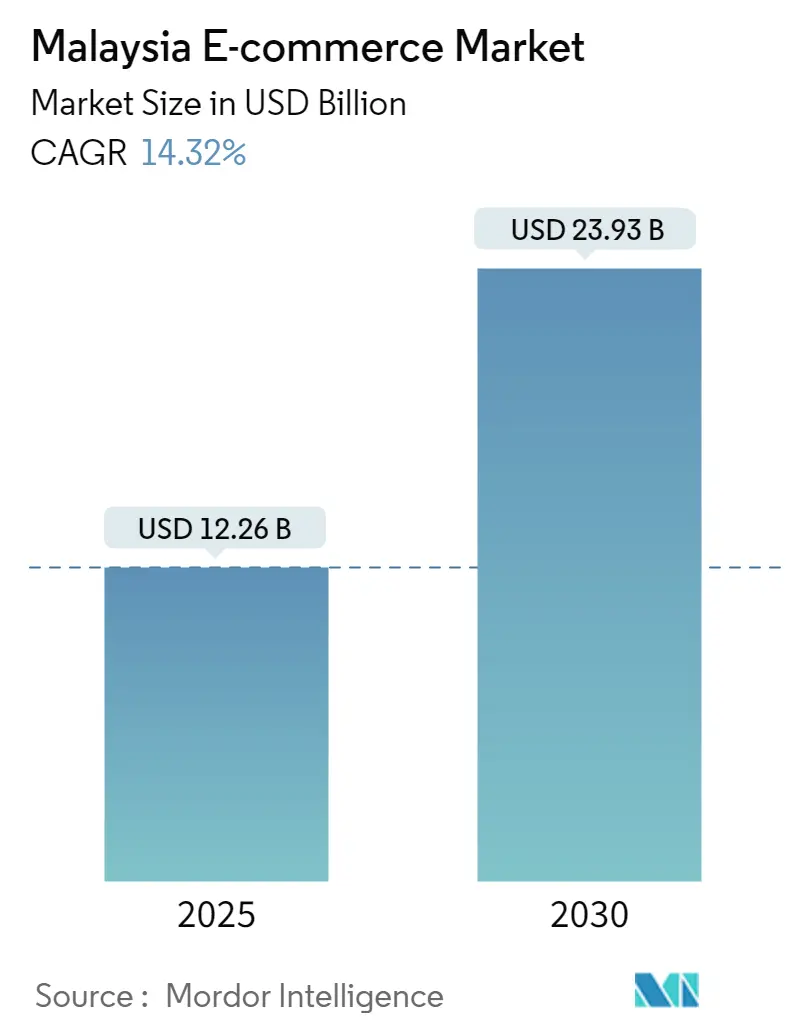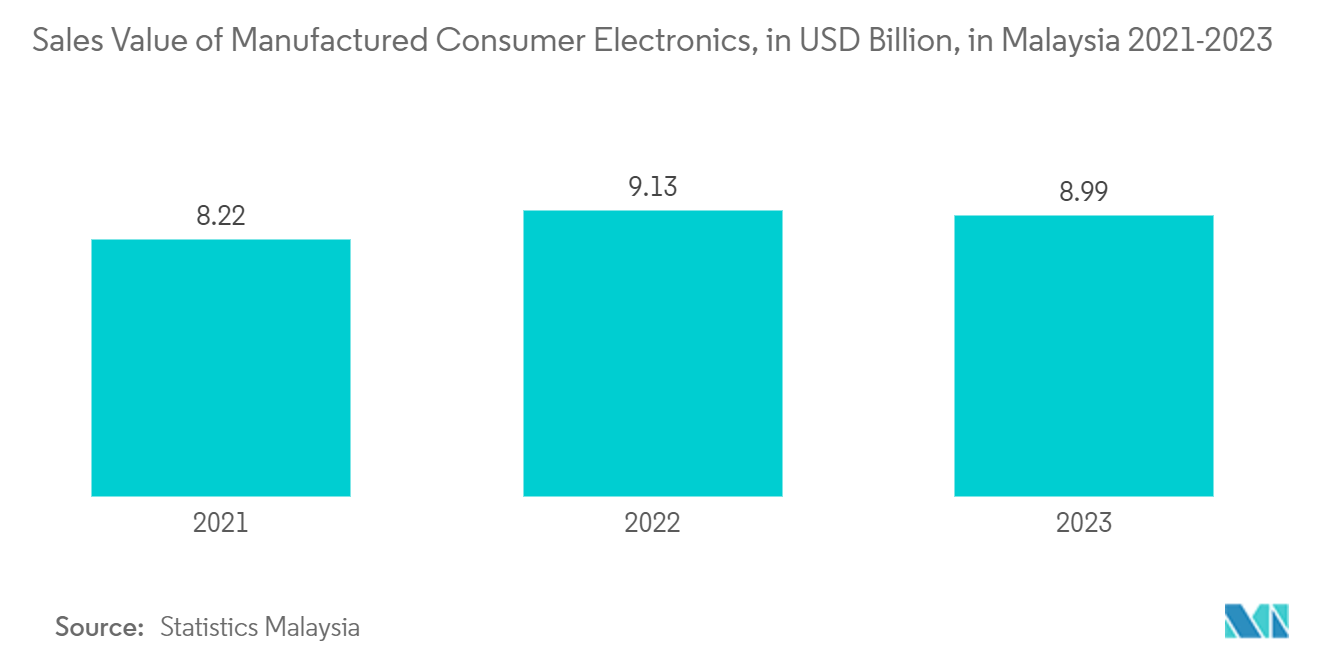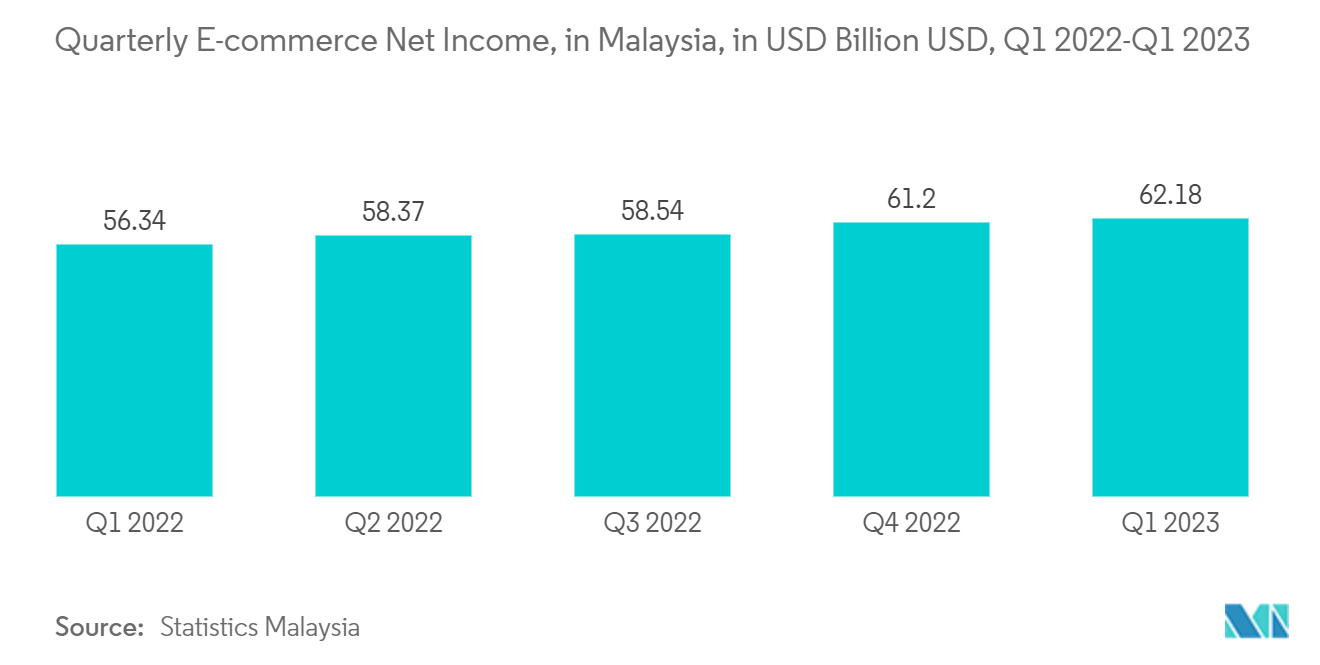
| Study Period | 2019 - 2030 |
| Base Year For Estimation | 2024 |
| Forecast Data Period | 2025 - 2030 |
| Market Size (2025) | USD 12.26 Billion |
| Market Size (2030) | USD 23.93 Billion |
| CAGR (2025 - 2030) | 14.32 % |
| Market Concentration | Medium |
Major Players
*Disclaimer: Major Players sorted in no particular order |
Malaysia E-commerce Market Analysis
The Malaysia E-commerce Market size is estimated at USD 12.26 billion in 2025, and is expected to reach USD 23.93 billion by 2030, at a CAGR of 14.32% during the forecast period (2025-2030).
- The e-commerce market is experiencing growth due to increasing internet penetration, access in developing economies, smartphone usage, technological advancements, and rapid urbanization.
- The primary factors fueling the market's expansion are consumer electronics, fashion and apparel, and personal care industries. Significant investments in consumer electronics, personal care, and fashion and clothing sectors are opening up possibilities for growth.
- According to Statistics Malaysia, in 2023, almost all individuals in the country accessed the internet through their mobile phones. Additionally, about 38% of users reported using the internet from their laptops, while 13% reported utilizing alternative mobile gadgets.
- The Malaysian government’s proactive stance in fostering a digital economy has played a crucial role. Initiatives like the Digital Free Trade Zone (DFTZ) and the National E-commerce Strategic Roadmap have been instrumental in encouraging both local and international players to participate in the Malaysian e-commerce market. These policies not only streamlined regulatory processes but also provided incentives for e-commerce businesses, thereby catalyzing growth and innovation in the market.
- The government is implementing supportive measures for e-commerce. For example, in October 2023, PIKOM and e-Commerce Malaysia endorsed a careful and positive strategy for TikTok Shop, emphasizing the importance of proactive discussions with industry associations and e-commerce enablers. The focus was on local policies and developing the skills of local creators and e-commerce facilitators rather than foreign ones by providing workshops, training, and platform tools that help local players succeed in the digital market ethically.
- E-commerce companies recognize the importance and requirement of mobile commerce (m-commerce) in developing their existing and upcoming omnichannel strategies through effective, easy-to-use applications. During the forecast period, the rollout of 5G is expected to be a key driver of increased mobile traffic from consumer-facing websites across the country.
- According to Malaysia's Commercial Crime Investigation Department (CCID), by September 2023, Malaysia had recorded over 8,800 e-commerce scams. The tenacity of fraud hindered the market's expansion, which eroded purchasers' faith.
Malaysia E-commerce Market Trends
Government Initiatives Are Boosting the Adoption of Digital Solutions
- The Malaysian government also recognizes the rise in e-commerce. In the first quarter of 2023, the net income of e-commerce in Malaysia surpassed MYR 291 billion (USD 62.18 billion), increasing from around MYR 287 billion (USD 61.20 billion) in the previous quarter. The quarterly net income of e-commerce in the country has been steadily increasing over the past few years.
- The previously mentioned factor is seen as a means of promoting inclusivity by the government, which has pledged assistance to boost local micro, small, and medium enterprises (MSMEs). Additionally, Digital Free Trade Zones have been established to ease cross-border e-commerce and expand the market for MSMEs.
- The digital sector contributed USD 1.162 trillion to Malaysia's GDP, as reported by the Malaysian Finance Ministry. It is expected that over 500,000 new jobs will be created by 2025. The government actively collaborates with the private sector to encourage consumers to adopt digital services and to assist small businesses through incentives and support.
- The government unveiled an action plan with eight points. Some options include restructuring existing economic incentives and reducing non-tariff barriers such as consumer protection, cross-border, and e-fulfillment. Other strategies involve providing targeted funding for selected e-commerce firms and showcasing local brands to boost global e-commerce.
- The Digital Economy Blueprint outlines plans for Malaysia's digital transformation in sectors such as e-commerce, which will be executed by 2030. It lays out plans and actions to encourage digital usage, boost skill growth, improve digital resources, and establish a favorable regulatory setting. The plan intends to drive Malaysia's digital economy and establish the country as a key hub for e-commerce and digital innovation.
Consumer Electronics is Expected to Witness Growth
- According to the Malaysian Department of Statistics, the sales value of manufactured consumer electronics in Malaysia was approximately MYR 42.21 billion (USD 8.99 billion). The sales value of consumer electronics produced has fluctuated over the years. Nevertheless, e-commerce has been crucial as more ordinary individuals buy items online.
- Technology can improve individuals' lives by utilizing consumer electronics. The emergence of Industry 4.0 has accelerated the development of innovative consumer products, increasing the demand for smart consumer goods incorporating state-of-the-art technologies such as IoT, AR, VR, and AI.
- Some factors propelling the consumer electronics market include technological advancements, changing customer preferences, and the increasing need for affordable, user-friendly, and effective goods. Consumer electronics include smartphones, household appliances, computers, laptops, televisions, game consoles, and wearables. As product launches increase in the consumer electronics sector, e-commerce is becoming more popular for purchasing those items.
- The rising emphasis on luxury items in the consumer goods sector by domestic consumers is expected to boost the need for quality headphones and big-screen smart TVs. This trend is expected to push the market’s current value growth above the growth in retail foot traffic.

Malaysia E-commerce Industry Overview
Due to a few big competitors, the level of competition in the Malaysian e-commerce market is medium. The market is semi-consolidated. The number of local and global brands is increasing, which increases market competition.
- January 2024: ZALORA, an e-commerce platform for fashion and lifestyle, introduced an AI-driven chatbot for customer service in Singapore, Malaysia, the Philippines, Indonesia, Hong Kong, and Taiwan to improve customer support. The chatbot, developed in collaboration with Forethought, utilizes generative AI to manage customer queries. It is able to transition between languages smoothly, delivering precise answers using natural language processing.
- October 2023: Lazada backed MSMEs in Indonesia by running the Sustainable Seller Acceleration Camp 2023. This program provided comprehensive training to help businesses incorporate sustainable practices and gain access to financial opportunities.
Malaysia E-commerce Market Leaders
-
Shopee Pte. Ltd.
-
Lazada Group
-
Lelong.my
-
Zalora Group
-
Astro GS Shop Sdn Bhd
- *Disclaimer: Major Players sorted in no particular order

Malaysia E-commerce Market News
- May 2024: Malaysia and Amazon boosted their partnership to improve cross-border e-commerce development due to increased demand from Malaysian businesses. The goal is to promote cross-border e-commerce, support Malaysian brand owners in launching their businesses with Amazon, and showcase more Malaysian brands and products to US customers.
- February 2024: ZALORA, known as Asia's Fashion Expert, introduced the ZALORAYA 2024 campaign with an engaging experience, promising to highlight fashion clothing, accessories, beauty items, and traditional attire. It showcases Malaysia's diverse cultural richness and features two Indonesian brands, Ria Atelier and Embara. These brands were well-received, and they are anticipated to enthrall the Malaysian and Singaporean markets with their distinctive incorporation of various designs and cultural elements, infusing an international vibe into the festivities.
Malaysia E-commerce Industry Segmentation
E-commerce includes business-to-business (B2B) and business-to-consumer (B2C) transactions and internal organizational transactions that support these activities. The study tracks essential market factors, underlying growth influencers, and significant market vendors to provide estimations and growth rates for the forecast period. The study also examines the overall impact of COVID-19 on the market.
The Malaysian e-commerce market is segmented by B2C e-commerce (beauty and personal care, consumer electronics, fashion and apparel, food and beverage, furniture and home, and others (toys, DIY, media, etc.)) and B2B e-commerce. The market sizes and forecasts are provided in terms of value (USD) for all the above segments.
| By B2C ecommerce | Market Segmentation - by Application | Beauty and Personal Care |
| Consumer Electronics | ||
| Fashion and Apparel | ||
| Food and Beverage | ||
| Furniture and Home | ||
| Others (Toys, DIY, Media, etc.) | ||
| By B2B ecommerce | Market size for the period of 2017-2027 |
Malaysia E-Commerce Market Research FAQs
How big is the Malaysia E-commerce Market?
The Malaysia E-commerce Market size is expected to reach USD 12.26 billion in 2025 and grow at a CAGR of 14.32% to reach USD 23.93 billion by 2030.
What is the current Malaysia E-commerce Market size?
In 2025, the Malaysia E-commerce Market size is expected to reach USD 12.26 billion.
Who are the key players in Malaysia E-commerce Market?
Shopee Pte. Ltd., Lazada Group, Lelong.my, Zalora Group and Astro GS Shop Sdn Bhd are the major companies operating in the Malaysia E-commerce Market.
What years does this Malaysia E-commerce Market cover, and what was the market size in 2024?
In 2024, the Malaysia E-commerce Market size was estimated at USD 10.50 billion. The report covers the Malaysia E-commerce Market historical market size for years: 2019, 2020, 2021, 2022, 2023 and 2024. The report also forecasts the Malaysia E-commerce Market size for years: 2025, 2026, 2027, 2028, 2029 and 2030.
Our Best Selling Reports
Malaysia E-Commerce Industry Report
The Global Ecommerce Market, experiencing a significant upward trajectory, is driven by a surge in consumer demand across various segments, including retail, travel, and hospitality. This expansive growth, highlighted by the sale of goods from food to luxury items through digital channels, is revolutionizing consumer shopping habits and business operations. With a focus on sustainability, the shift towards eco-friendly practices like paper packaging materials aligns with consumer preferences for environmentally responsible products. The market's evolution is supported by technological advancements and mobile device adoption, making online shopping more accessible. In Malaysia, the eCommerce sector is witnessing remarkable growth, as detailed in Mordor Intelligence™ Industry Reports, which offer insights into market share, size, and revenue growth rates. This dynamic environment presents numerous opportunities for innovation, catering to changing consumer needs and technological progress. For detailed insights, Mordor Intelligence™ provides free report PDF download, showcasing Malaysia's eCommerce analysis and market forecast.





